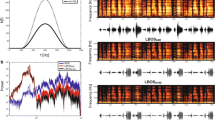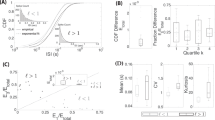Summary
Extracellular recording from single auditory nerve fibres in the lizard,Gekko gecko, revealed interesting patterns of evoked and spontaneous activity. The fibres are sensitive and sharply tuned (Figs. 1 and 3) and have characteristic frequencies (CFs) from 0.15 to 5 kHz (Fig. 2). Responses to pure tone bursts fall into three main categories with different frequency distributions (Figs. 5, 6 and 7): 1) tonic; such fibres have CFs<0.7 kHz; 2) phasic, restricted to CFs>0.7 kHz; 3) intermediate, with an intermediate frequency range: 0.4–2 kHz. As there is also some intensity dependence to these response patterns, fibres were classified according to their responses to tones at 20 dB (above threshold). Within small samples of fibres drawn from the three categories, all were susceptible to two-tone suppression (Fig. 10) and responded to a broad-band Tokay call (Fig. 11). Possible correlations between these categories and populations of cochlear hair cells that differ with respect to orientation and tectorial connections are discussed. A few fibres (10 in 410) were seen to respond to both onset and offset of certain pure tones (Fig. 9).
Interspike interval histograms revealed that fibres with CFs≧0.5 kHz have spontaneous discharge patterns comparable to those that have been described in other species, despite low discharge rates (Figs. 12 and 13). However, fibres with CFs≦0.5 kHz tend to fire spontaneously at intervals close to the CF period or integral multiples thereof (Fig. 13). We propose that this spontaneous discharge pattern may reflect ‘ringing’ of hair cells at their CFs and so may provide indirect evidence that hair cell membranes possess a tuned system of conductances.
Similar content being viewed by others
Abbreviations
- CF :
-
characteristic frequency
- PSTH :
-
peristimulus time histogram
References
Bennett MVL (1967) Mechanisms of electroreception. In: Kahn P (ed) Lateral line detectors. University of Indiana Press, Bloomington, pp 313–393
Campbell HW (1969) The effects of temperature on the auditory sensitivity of lizards. Physiol Zool 42:183–210
Capranica RR (1976) Morphology and physiology of the auditory system. In: Llinàs R, Precht W (eds) Frog neurobiology. Springer, Berlin Heidelberg New York, pp 551–575
Corey DP, Hudspeth AJ (1979) Ionic basis of the receptor potential in a vertebrate hair cell. Nature 281:375–677
During M von, Karduck A, Richter H-G (1974) The fine structure of the inner ear in Caiman crocodilus. Z Anat Entwickl Gesch 145:41–65
Eatock RA, Manley GA (1981) Auditory nerve fibre activity in the Tokay gecko: II. Temperature effect on tuning. J Comp Physiol 142:219–226
Evans EF (1972) The frequency response and other properties of single fibres in the guinea pig cochlear nerve. J Physiol 226:263–287
Evans EF (1974) Auditory frequency selectivity and the cochlear nerve. In: Zwicker E, Terhardt F (eds) Facts and models in hearing. Springer, Berlin Heidelberg New York, pp 118–129
Fettiplace R, Crawford AC (1978) The coding of sound pressure and frequency in cochlear hair cells of the terrapin. Proc R Soc Lond [Biol] 203:209–218
Flock Å, Wersäll J (1962) A study of the orientation of the sensory hairs of the receptor cells in the lateral line organ of a fish with special reference to the function of the receptors. J Cell Biol 15:19–27
Frishkopf LS, Flock Å (1974) Ultrastructure of the basilar papilla, an auditory organ in the bullfrog. Acta Otolaryngol (Stockholm) 77:176–184
Hepp-Reymond M-C, Palin J (1968) Patterns in the cochlear potentials of the Tokay gecko (Gekko gecko). Acta Otolaryngol (Stockholm) 65:270–292
Hill KG, Lewis DB, Hitchings ME, Coles RB (1980) Directional hearing in the Japanese Quail, I.: Acoustic properties of the auditory system. J Exp Biol 86:135–151
Holton T, Weiss TF (1977) Two-tone rate suppression in lizard cochlear nerve fibres: relation to auditory receptor morphology. J Acoust Soc Am 62, Suppl 1:545
Hopkins CD (1976) Stimulus filtering and electroreception: tuberous electroreceptors in three species of gymnotoid fish. J Comp Physiol 111:171–207
Hudspeth AJ, Corey DP (1977) Sensitivity, polarity and conductance change in the response of vertebrate hair cells to controlled mechanical stimuli. Proc Natl Acad Sci USA 74:2407–2411
Kiang NY-S, Watanabe T, Thomas EC, Clark LF (1965) Discharge patterns of single fibres in the cat's auditory nerve. MIT Press, Cambridge, MA
Klinke R, Pause M (1977) The performance of a primitive hearing organ of the cochlea type: primary fibre studies in the caiman. In: Evans EF, Wilson JP (eds) Psychophysics and physiology of learning. Academic Press, London, pp 101–113
Konishi M (1970) Comparative neurophysiological studies of hearing and vocalization in song birds. Z Vergl Physiol 66:257–272
Lewis ER, Li CW (1975) Hair cell types and distributions in the otolithic and auditory organs of the bullfrog. Brain Res 83:35–50
Manley GA (1972a) Frequency response of the ear of the Tokay gecko. J Exp Zool 181:159–168
Manley GA (1972b) The middle ear of the Tokay gecko. J Comp Physiol 81:239–250
Manley GA (1974) Activity patterns of neurons in the peripheral auditory system of some reptiles. Brain Behav Evol 10:244–256
Manley GA (1977) Response patterns and peripheral origin of auditory nerve fibres in the monitor lizard,Varanus bengalensis. J Comp Physiol 118:249–260
Manley GA (1979) Preferred intervals in the spontaneous activity of primary auditory neurons. Naturwissenschaften 66:582–583
Manley GA, Leppelsack H-J (1977) Preliminary data on activity patterns of cochlear ganglion neurons in the starling,Sturnus vulgaris. In: Portmann M, Aran J-M (eds) Inner ear biology. INSERM, Paris, pp 127–136
Manley GA, Robertson D (1976) Analysis of spontaneous activity of auditory neurones in the spiral ganglion of the guinea-pig cochlea. J Physiol 258:323–336
Miller MR (1966) The cochlear duct of lizards. Proc Calif Acad Sci 33: 235–239
Miller MR (1973a) A scanning electron microscope study of the papilla basilaris ofGekko gecko. Z Zellforsch 136:307–328
Miller MR (1973b) Scanning electron microscope studies of some lizard basilar papillae. Am J Anat 138:301–330
Miller MR (1974) Scanning electron microscope studies of the lizard papilla basilaris. Brain Behav Evol 10:95–112
Miller MR (1975) The cochlear nuclei of lizards. J Comp Neurol 159:375–406
Miller MR (1978) Further scanning electron microscope studies of lizard auditory papillae. J Morphol 156:381–418
Nadol JB Jr, Mulroy MJ, Goodenough DA, Weiss TF (1977) Tight and gap junctions in a vertebrate inner ear. Am J Anat 147:281–302
Robertson D (1976a) Correspondence between sharp tuning and two-tone inhibition in primary auditory neurons. Nature 259:477–478
Robertson D (1976b) Possible relation between structure and spike shapes in neurons in guinea pig cochlear ganglion. Brain Res 109:487–596
Robertson D, Manley GA (1974) Manipulation of frequency analysis in the cochlear ganglion of the guinea pig. J Comp Physiol 91:363–375
Russell U, Sellick PM (1977) Tuning properties of cochlear hair cells. Nature 267:858–860
Russell IJ, Sellick PM (1978) Intracellular studies of hair cells in the mammalian cochlea. J Physiol 284:261–290
Sachs MB (1964) Responses to acoustic stimuli from single units in the eighth nerve of the green frog. J Acoust Soc Am 36: 1956–1958
Sachs MB, Kiang NY-.S (1968) Two tone inhibition in auditory nerve fibres. J Acoust Soc Am 43:1120–1128
Sachs MB, Young ED, Lewis RH (1974) Discharge patterns of single fibres in the pigeon auditory nerve. Brain Res 70:431–447
Sammaritano-Klein MR (1976) Response patterns of single neurons in the midbrain of the Tokay gecko. M. Se. thesis, McGill University, Montreal, Canada
Suga N, Simmons JA, Jen PH-S (1975) Peripheral specialization for fine analysis of Doppler-shifted echos in the auditory system of the ‘CF-FM’ bat,Pteronotus parnellii. J Exp Biol 63:161–192
Takasaka T, Smith CA (1971) The structure and innervation of the pigeon's basilar papilla. J Ultrastruct Res 35:20–65
Weiss TF, Mulroy MJ, Altmann DW (1974) Intracellular responses to acoustic clicks in the inner ear of the alligator lizard. J Acoust Soc Am 55:606–619
Weiss TF, Mulroy MJ, Turner RG, Pike CL (1976) Tuning of single fibres in the cochlear nerve of the alligator lizard: relation to receptor morphology. Brain Res 115:71–90
Weiss TF, Peake WT, Ling A Jr, Holton T (1978) Which structures determine frequency selectivity and tonotopic organization of vertebrate nerve fibres? Evidence from the alligator lizard. In: Naunton RF (ed) Evoked electrical activity in the auditory nervous system. Academic Press, New York, pp 91–112
Werner YL, Wever EG (1972) The function of the middle ear in lizards:Gekko gecko andEublepharis macularius (Gekkonoidea). J Exp Zool 179:1–16
Wever EG (1967) The tectorial membrane of the lizard ear: species variations. J Morphol 122:307–320
Wever EG (1974) The lizard ear: Gekkonidae. J Morphol 143:121–166
Wever EG, Peterson EA (1963) Auditory sensitivity in three iguanid lizards. J Aud Res 3:205–212
Wever EG, Crowley DE, Peterson EA (1963) Auditory sensitivity in four species of lizards. J Aud Res 3:151–157
Wever EG, Peterson EA, Crowley DE, Vernon JA (1964) Further studies of hearing in the gekkonid lizards. Proc Natl Acad Sci USA 51:561–567
Author information
Authors and Affiliations
Additional information
This work constitutes partial fulfillment of the requirements for the M.Sc. degree of R.A.E.
We thank D.P. Corey and D.C. Van Essen for critical reading of the manuscript. This work was supported by grants from the National Research Council of Canada and the Québec Dept. of Education.
Rights and permissions
About this article
Cite this article
Eatock, R.A., Manley, G.A. & Pawson, L. Auditory nerve fibre activity in the tokay gecko. J. Comp. Physiol. 142, 203–218 (1981). https://doi.org/10.1007/BF00605739
Accepted:
Issue Date:
DOI: https://doi.org/10.1007/BF00605739




